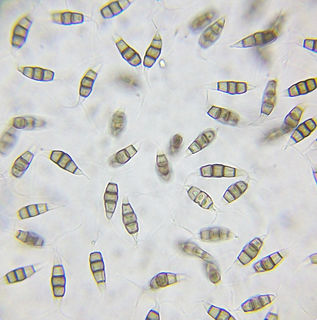
Hypericum is a genus of flowering plants in the family Hypericaceae. Hypericum is unusual for a genus of its size because a worldwide taxonomic monograph was produced for it by Norman Robson. Robson recognizes 36 sections within Hypericum.
Hypericum asplundii is a species of flowering plant in the family Hypericaceae. It is endemic to Ecuador, where it is known from a single collection made outside of Machachi.
Hypericum balfourii is a species of flowering plant in the family Hypericaceae. It is endemic to Socotra, an island archipelago that is part of Yemen. It grows in mountain shrubland dominated by Cephalocroton. It is usually found on granite terrain above 600 meters in elevation.
Hypericum fieriense is a species of flowering plant in the family Hypericaceae. It is endemic to Socotra, an island archipelago that is part of Yemen. It grows in mountain shrubland dominated by Cephalocroton, where it can be found with the endemic tree Dracaena cinnabari. It is rarer than other local shrubby Hypericum species. It can be distinguished from them by its pubescent herbage.
Hypericum gnidiifolium is a species of flowering plant in the family Hypericaceae. It is endemic to Ethiopia, where it has been observed at only two locations. It grows next to streams.
Hypericum hartwegii is a species of shrub in the family Hypericaceae. It is endemic to Ecuador. It was collected twice in 1841 in Loja Province, and it has not been seen since.
Hypericum llanganaticum is a species of shrub in the family Hypericaceae. It is endemic to Ecuador. It grows in the Andes at elevations between 3000 and 4500 meters. Most collections have been made in Parque Nacional Llanganates.
Hypericum maguirei is a species of shrub in the family Hypericaceae. It is endemic to Ecuador, where it grows in the páramo of the Andes. It occurs at elevations between 2000 and 4000 meters.
Hypericum matangense is a species of shrub in the family Hypericaceae. It is endemic to Ecuador. It has only been collected once, on the páramos of the Andes in 1980.
Hypericum prietoi is a species of shrub in the family Hypericaceae. It is endemic to Ecuador, where it has only been collected once, in 1945.
Hypericum quitense is a species of flowering plant in the family Hypericaceae. It is endemic to Ecuador. Its occurs in several types of habitat at elevations between 2,000 and 4,050 meters in the Andes.

Hypericum scopulorum is a species of flowering plant in the family Hypericaceae. It is endemic to Socotra, an island archipelago that is part of Yemen. It is a common plant in shrubland habitat, and it is a dominant species in some areas along with Cephalocroton and another local endemic, Helichrysum rosulatum.
Hypericum socotranum is a species of flowering plant in the Hypericaceae family. It is found only on the island of Socotra in Yemen. Its natural habitats are subtropical or tropical dry forests and rocky areas.
Hypericum tortuosum is a species of flowering plant in the Hypericaceae family. It is found only in Socotra, Yemen. Its natural habitats are subtropical or tropical dry forests and subtropical or tropical dry shrubland.

Hypericum elodes, commonly known as marsh St John's-wort, is a flowering plant native to Western Europe.

Pestalotiopsis microspora is a species of endophytic fungus capable of breaking down and digesting polyurethane. Originally identified in fallen foliage of common ivy in Buenos Aires, it also causes leaf spot in Hypericum 'Hidcote' shrubs in Japan.
Norman Keith Bonner Robson is a Scientific Associate in the Plants Division, Department of Life Sciences at the Natural History Museum, London. He was a member of staff at the Museum from 1962–1988, retiring as Principal Scientific Officer with responsibility for General Herbarium Section I.

Hypericum aegypticum, also known as Egyptian Saint John's wort, is an evergreen shrub or shrublet in the section Adenotrias of the genus Hypericum. Less frequently, dwarf Saint John's wort is used as an alternate name.

Hypericum huber-morathii is a flowering plant in the genus Hypericum, in the section Adenosepalum, and is the type species of the Hypericum huber-morathii group.









